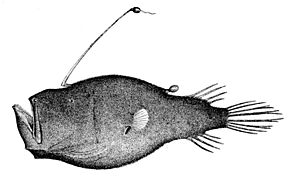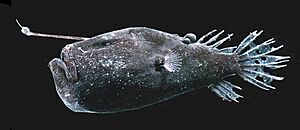Triplewart seadevil facts for kids
Quick facts for kids Triplewart seadevil |
|
|---|---|
 |
|
| Triplewart seadevil (female) | |
| Conservation status | |
| Scientific classification |
The triplewart seadevil (Cryptopsaras couesii) is a fascinating deep-sea fish. It belongs to a group of fish called anglerfish. This unique fish is the only species in its genus. Triplewart seadevils are known for being very different in size between males and females. Females can grow to be 20 to 30 centimeters long. Males are much smaller, only 1 to 3 centimeters long.
Contents
Where They Live
Triplewart seadevils live all over the world in every major ocean. They are found deep in the water, from 75 to 4000 meters (about 250 to 13,100 feet) down. Most of them live between 500 and 1250 meters (about 1600 to 4100 feet). These fish are not strong swimmers. Ocean currents can carry them long distances. This helps them spread out across the deep ocean.
What They Look Like
Female triplewart seadevils have a body that is flat on the sides. Their bodies are also long and thin. They have a big head and a mouth that points almost straight up when closed. Their mouths have two or three rows of teeth. The teeth on their lower jaw are much bigger than those on their upper jaw.
Their bodies are covered in hollow spines. Only the tips of these spines show. They also have three special bumps on their sides. These bumps have glands that make a glowing slime. Adult females are jet-black. Young ones are dark brown.
Their Fishing Rod
The triplewart seadevil uses a special "fishing rod" to catch food. This rod is called an illicium. It is a changed fin spine on their snout. At the end of this rod is a lure, called an esca. This lure glows because it has tiny living things inside it. These tiny living things are bioluminescent bacteria. They create light. The fish can move this rod to wave its glowing lure. This helps it attract prey in the dark deep ocean.
Male and Female Differences
This species shows extreme sexual dimorphism. This means males and females look very different. Male triplewart seadevils are much smaller than females. They also attach themselves to the larger females.
Males have special teeth on their jaw. These teeth help them grab onto a female mate. Once a male attaches, his body joins with the female's body. He becomes permanently connected to her. After attaching, the male gets all his food from the female. This happens because their bodies connect.
This unusual way of life helps the fish survive. The deep ocean is a huge place. It can be hard for a male to find a female. By attaching, the male makes sure he can reproduce. This greatly increases his chances of having offspring.
Life Cycle
Triplewart seadevils lay eggs more than once a year. In the Atlantic Ocean, young triplewart seadevils are found for most of the year. They are most common during the summer months.




